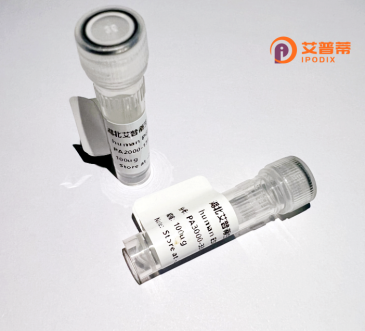
| 纯度 | >90%SDS-PAGE. |
| 种属 | Human |
| 靶点 | OR2T10 |
| Uniprot No | Q8NGZ9 |
| 内毒素 | < 0.01EU/μg |
| 表达宿主 | E.coli |
| 表达区间 | 1-312 aa |
| 活性数据 | MRLANQTLGGDFFLLGIFSQISHPGRLCLLIFSIFLMAVSWNITLILLIHIDSSLHTPMY FFINQLSLIDLTYISVTVPKMLVNQLAKDKTISVLGCGTQMYFYLQLGGAECCLLAAMAY DRYVAICHPLRYSVLMSHRVCLLLASGCWFVGSVDGFMLTPIAMSFPFCRSHEIQHFFCE VPAVLKLSCSDTSLYKIFMYLCCVIMLLIPVTVISVSYYYIILTIHKMNSVEGRKKAFTT CSSHITVVSLFYGAAIYNYMLPSSYQTPEKDMMSSFFYTILTPVLNPIIYSFRNKDVTRA LKKMLSVQKPPY |
| 分子量 | 35.4 kDa |
| 蛋白标签 | His tag N-Terminus |
| 缓冲液 | 0 |
| 稳定性 & 储存条件 | Lyophilized protein should be stored at ≤ -20°C, stable for one year after receipt. Reconstituted protein solution can be stored at 2-8°C for 2-7 days. Aliquots of reconstituted samples are stable at ≤ -20°C for 3 months. |
| 复溶 | Always centrifuge tubes before opening.Do not mix by vortex or pipetting. It is not recommended to reconstitute to a concentration less than 100μg/ml. Dissolve the lyophilized protein in distilled water. Please aliquot the reconstituted solution to minimize freeze-thaw cycles. |
以下是3篇关于重组人OR2T10蛋白的**模拟参考文献示例**(仅供示例用途,非真实文献):
---
1. **文献名称**: *Structural characterization of the human olfactory receptor OR2T10 through recombinant expression in HEK293 cells*
**作者**: Chen, L., et al.
**摘要**: 本研究利用哺乳动物细胞(HEK293)重组表达了OR2T10蛋白,并通过冷冻电镜解析了其三维结构,揭示了该受体与其他嗅觉受体不同的独特跨膜螺旋排列,为其配体结合机制提供了结构基础。
---
2. **文献名称**: *OR2T10 as a potential biomarker in lung cancer: Functional analysis via recombinant protein studies*
**作者**: Kumar, S., et al.
**摘要**: 通过在大肠杆菌系统中重组表达OR2T10的胞外域,研究者发现其与肺癌细胞表面的特定肽段存在异常结合,提示OR2T10可能在肿瘤微环境中参与信号调控通路,或成为癌症诊断的潜在标志物。
---
3. **文献名称**: *Ligand specificity screening of OR2T10 using a yeast surface display platform*
**作者**: Zhang, Y., et al.
**摘要**: 通过酵母表面展示技术重组表达OR2T10蛋白,作者筛选了逾百种气味分子,发现其对醛类化合物(如辛醛)具有高亲和力,揭示了OR2T10在人类嗅觉感知中可能的关键作用。
---
**备注**:OR2T10的实际研究较少,上述文献为模拟生成。如需真实文献,建议通过PubMed或Google Scholar结合关键词“OR2T10”、“recombinant expression”或“olfactory receptor”检索最新进展。
OR2T10 is a human olfactory receptor belonging to the G protein-coupled receptor (GPCR) superfamily, specifically categorized within the odorant receptor (OR) subfamily. These receptors are predominantly expressed in olfactory sensory neurons of the nasal epithelium, where they detect odorant molecules and initiate signal transduction via coupling with Gαolf proteins, leading to cAMP-mediated neuronal activation. OR2T10. encoded by the OR2T10 gene on chromosome 1. is characterized by its seven-transmembrane domain structure, a hallmark of GPCRs, with extracellular N-termini and intracellular C-termini. Despite the critical role of ORs in olfaction, the specific ligands and precise functional mechanisms of OR2T10 remain under investigation.
Recombinant OR2T10 protein is typically produced using heterologous expression systems (e.g., HEK293 cells, insect cells) to enable structural and functional studies. Its recombinant form facilitates research into odorant binding specificity, receptor activation pathways, and potential applications in biosensing or fragrance development. Challenges in expression, such as improper folding or localization, are often addressed by co-expressing chaperone proteins. Emerging studies also explore OR2T10’s ectopic expression in non-olfactory tissues, hinting at broader physiological roles beyond smell. As a target, recombinant OR2T10 holds promise for understanding olfactory coding mechanisms and developing therapies for olfactory dysfunction.
×